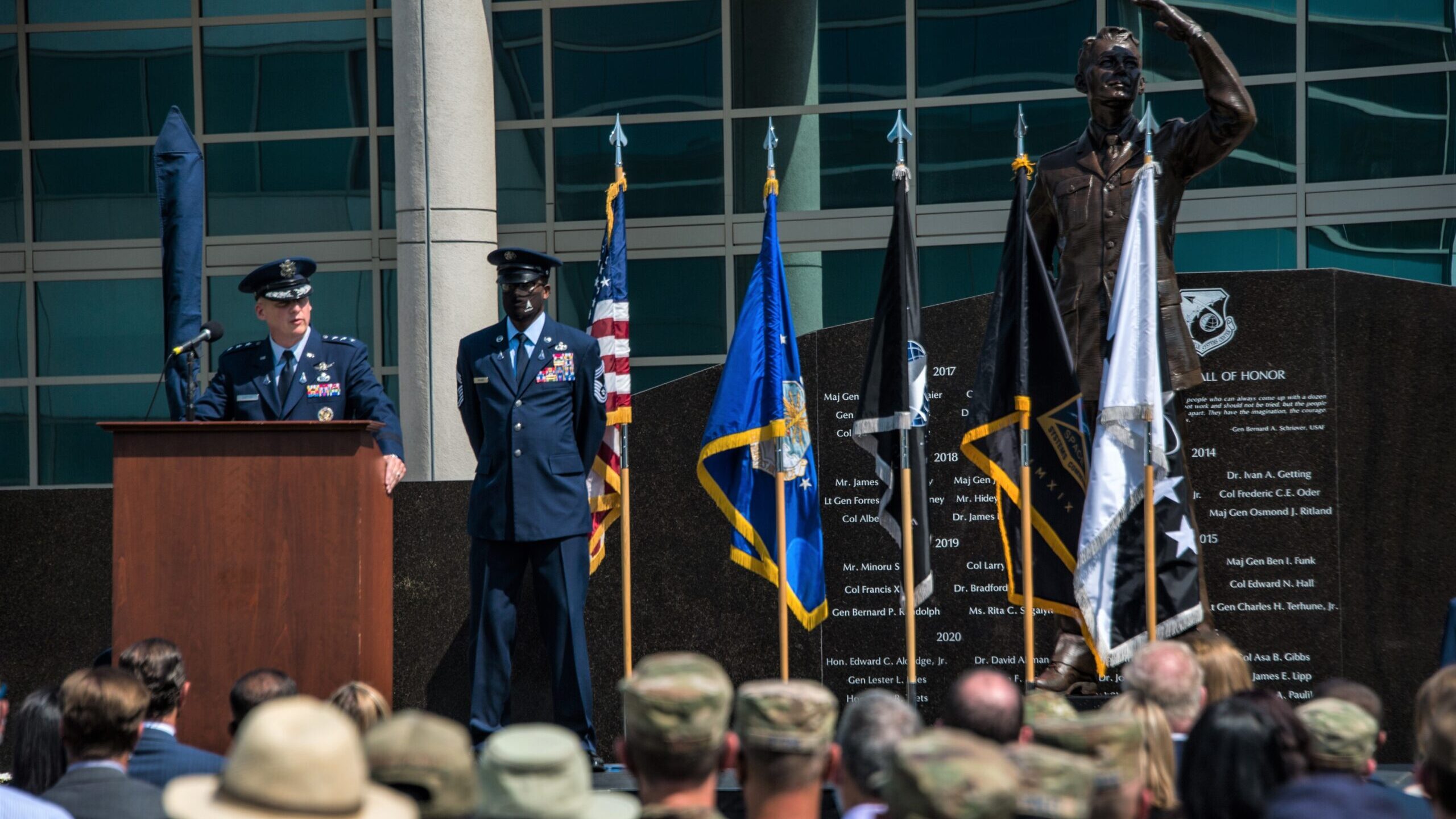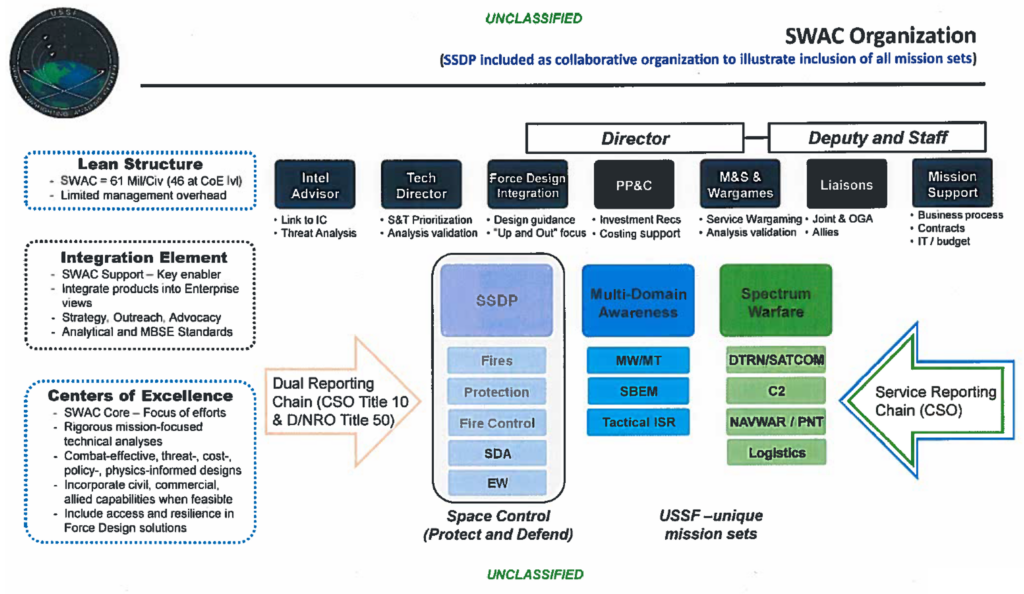THERESA HITCHENS

WASHINGTON: While Space Force’s fledgling Space Warfighting Analysis Center (SWAC) initially faced pushback on Capitol Hill, a number of key members of Congress have been won over in recent months — to the point where it is now seen as a ray of hope for long-stalled space acquisition reform.
Meanwhile, yet another reorganization of the central service body for developing and buying new satellites and space systems — reimagined as Space Systems Command in August and led by Lt. Gen. Michael Guetlein — is in the works, a number of sources said. Though a Space Force spokesperson said that re-org is “pre-decisional,” the sources said SWAC provides a model for what the new organization will look like — more proof of the SWAC’s success.
Rep Jim Cooper, chairman of the House Armed Services strategic forces subcommittee, said in an interview last week that the SWAC’s first (classified) industry day on Oct. 27 was a “very promising development.”
The SWAC team, which is led by longtime Defense Department space official Andrew Cox, took a “very bold approach, with nearly 200 commercial [companies], by sharing some of their toughest problems to see if some of the best minds in the space industry can help us solve those problems,” said Cooper, D-Tenn. “That was a very bold way to jumpstart the acquisition process. There’s some real opportunities there to accelerate things.”
Rep. Kay Granger, R-Texas, the ranking member of the House Appropriations Committee, told Breaking Defense in a written statement that SWAC’s force design efforts will set the stage for future space development programs.
“Of note, I am encouraged by their focus on force design and critical mission areas that are essential to space operations,” Granger said. “These efforts will underpin future investments that ensure we keep pace with our adversaries.”
Sen. Jim Inhofe, R-Okla., ranking member of the Senate Armed Services Committee, concurred.
“We established the Space Force to address the growing importance of space as a warfighting domain, and there has been significant progress in some areas—for example, the analysis from the Space Warfighting Analysis Center has structured space architecture across the Department of Defense.”
That three key players in Congress praised the SWAC unprompted is notable, given how many in Congress have been frustrated by the Pentagon’s snail’s pace in streamlining and realigning space acquisition efforts toward less vulnerable space systems — an issue that was one top raison d’être for Congress’s support for standing up the Space Force in the first place.
Indeed, both the House Armed Services Committee and the House Appropriations Committee, in their fiscal 2022 defense bills, zeroed out the Space Force’s $37 million request for the center’s work. However, the compromise version of the 2022 National Defense Authorization Act, recently passed by the House and Senate and headed to President Joe Biden desk, would allow the funds to be released, contingent of course on appropriators’ final decision.
The SWAC was unveiled by Chief of Space Operations Gen. Jay Raymond in his November 2020 CSO Planning Guidance. It is aimed at developing future “force design” for the central Space Force mission areas, such as missile warning and tracking — the first blueprint completed so far — and intelligence, surveillance and reconnaissance (ISR).
While little has been said about the center in the unclassified domain, the organization now is set up along those mission lines of effort, as shown in the center’s organizational chart, obtained by Breaking Defense.

Space Warfighting Analysis Center organizational chart (Space Force)
Eric Brown, senior director of mission strategy for Lockheed Martin’s Military Space business, explained that what Raymond and Air Force Secretary Frank Kendall are trying to do with SWAC is “to take a step back to say: ‘What does the future need to look like within a set of constraints based on budget, based on where we are in our programs today? We need to evolve to the future at a very fast clip, but we can’t do it without some forethought.'”
He added: “I think they’ve set up the foundations, the infrastructure that’s needed to really create that direction.”
The next question, Brown said, is whether Space Systems Command be able to transition those blueprints developed by SWAC into real-world programs.
“Do we see them starting to buy — not necessarily buy something different — but buy something in a more coherent, cogent fashion across the entire mission set?” he said.
Chris Bogdan, senior vice president for space and intelligence at Booz Allen Hamilton, agreed.
“We’ve seen the first force design coming out of the Space Warfighting Analysis Center recently,” he said. “We know that they’re doing a couple of others. And at least that’s intended to be the foundation of a plan. The question is really at that point in time, you know, are they incorporating the inputs that need to be there so that we’re not we’re not chasing our tail? And that’s where that Space Force is trying to be circumspect.”
Another SSC Reorganization Coming
While a Space Force spokesperson wouldn’t comment because the issue is still “pre-decisional,” a number of sources close to the action said that yet another reorganization for SSC is in the making. Kendall has approved the re-do and has passed responsibility over to Guetlein to make it so, these sources said, with a final product expected sometime early next year.
SSC, headquartered in Lost Angeles, was stood up from the bones of the Space and Missile Systems Center. SMC itself had, in July 2019, been overhauled with much fanfare into what Space Force called SMC 2.0.
The new idea, these sources explained, is to align SSC’s acquisition programs with the mission focus areas and force designs coming out of the SWAC.
“It’s been signed off, and they’ve talked publicly a little bit about it but it’s not complete yet,” said one space acquisition expert. “I think what Secretary Kendall is doing is, he wants to create SSC based on mission areas, rather than … a production corps, a development corps” which is SSC’s key organizational principle designed to “create a cross cutting organization.”
Under the new schema, the expert added, SSC would establish mission area teams and “then use some kind of integration or cross-cutting organization to try and tie them together.”
Whatever comes out of the overhaul, Congress will certainly want to be fully informed, as members keep keen eyes on space acquisition reform and, especially, the development of a more robust and resilient space architecture writ large.
“We’re pushing them,” Rep. Mike Rogers, R-Ala., said in an interview last week. “It’s one of the reasons we keep asking them to put it in writing what they want to do: so we can all understand how we’re going to get to where we need to be.
Rogers said “resilience” in space, the strengthening of American systems in the face of natural or man-made disruptions, is “the issue” for Space Force.
Rogers elaborated: “I want to see them start to reduce to writing, and that’s to all have a clear focus of how we’re going to move quickly to a much more resilient architecture — away from … the big fat, juicy targets.”
That resiliency must apply not just to moving toward large constellations of small satellites, but also to more capable constellations, as well as more launch capability for small satellites, he said.
“And I want to see us I want to see the Space Force start working more closely with commercial sector to leverage their capabilities for ISR and other things,” Rogers added. “Those are the things I’m focused on going forward. But I’m really happy where we are. And I could not be happier with the fact that this is one of the few things that is just not partisan in this town. The Space Force has strong bipartisan support.”
No comments:
Post a Comment